Best Practices L&D Professionals Need To Know For Simulation Training
A simulation is an imitation of a real-world process that is used to provide a realistic experience in a controlled environment. Industries have adopted simulations for the unique benefits it brings to each field. For many, it’s the ability for trainees to practice in a safe environment that makes it a preferred training option. For others, it’s allowing trainees the ability to understand human behavior, improve teamwork or build confidence that makes training simulations a favorite training vehicle. In order to capture all of the benefits this learning approach has to offer within your solution, integrate these simulation training best practices we have outlined below that have been collected from learning and development professionals across many industries.

Decide When To Offer
Busy employees like feeling in control of their professional development. The best time to provide access to your simulation is to have it always available, on-demand, for your learners to use whenever they need or want to gain experience. This way, learners can complete training at their own pace, creating a sense of ownership of their training goals.
Plan Your Frequency Of Use
Repetition solidifies behaviors you are aiming to teach. For maximum effectiveness, simulations should be repeated often and in short, repetitive sessions over a period of time rather than just in a single day.
Integrate Into Your Curriculum
The most ideal use of a simulation is to integrate it into a diverse training program, rather than having the simulation be a stand-alone and independent means of training. Nest the simulation within training curriculum that both provides a ground-level training that prepares them for the simulation as well as expands on the topics covered in your simulation.
Choose The Right Subject
Since simulations can be cost and time-intensive to create, be sure to maximize your efforts by choosing the best subjects for the medium. Some of the best uses for simulations include teaching the learner to perform multiple tasks simultaneously under pressure and replicating procedures that are too costly or dangerous to learn via hands-on practice. Be sure to steer clear of abstract theories, and stick to specific skills that learners can benefit to learn and apply to their workday.
Adapt To The Learner As Part Of Simulation Training Best Practices
Levels of difficulty in your simulation will allow for meaningful training to occur across your organization- from those that are new to your organization to those that are seasoned but need to advance their current skills. Allow for your simulation to graduate in complexity based on the learner’s performance.
Utilize Multiple Instructional Strategies
Offer simulations that use a range of instructional strategies to provide optimal benefits to your learners. For example, some simulations could be conducted in teams, promoting teamwork, communication, and leadership skills in addition to the knowledge gained through the use of the simulation alone.
Replication vs. Simulation
It’s important to remember that a simulation doesn’t have to — and in most cases, shouldn’t — be an exact replica of reality. As a strategy for your simulation training best practices, it is much more important to capture the essence of an experience rather than bog the learner down with all of the details. The U.S. Navy worked with a training simulation company to acclimate its trainees to foreign cultures. In one simulation, they abstracted many concepts like language and religion and focused on the details that were most easily grasped and generalized, such as portraying the difference between relationship-driven and task-oriented cultures. In the second simulation, they created a true-to-life replication of a Japanese train station down to every detail, equipped with Japanese-speaking merchants to staff ticket windows and shops. The first example proved to be highly effective, while the second overwhelmed the learners and proved to be too bogged down with extraneous detail.
Avoid Asking Learners To Take On A Persona
The purpose of a simulation is to provide an environment where learners can navigate the scenario based on decisions they feel are best. If you create a simulation in which participants pretend to play a role, they are creating a persona in which they can hide behind. In doing so, they do not own their actions and take a lot less away from the training. They can dismiss their decisions as those they felt the persona would do, rather than thinking deeply as to why they personally made that choice. It provides an opportunity for the learner to distance themselves from their decisions, while you want the learner to instead take ownership over these decisions in order to learn from them in a personal and meaningful way.
Facilitate A Debriefing
After your learners have participated in a training simulation, have a discussion with each to talk about the events that took place during their experience. During this discussion, provide them feedback on their performance. Offer praise for correct behavior, and guidance on how to improve on areas that need attention. Solicit feedback from all participants regarding the simulation, such as what they enjoyed or what could be improved. Allowing your employees to reflect on their experiences will help to cement the newly learned information.
In conclusion, it’s an exciting time to implement simulations in your training program. While industries such as military, aviation, and medical were among the early adopters of training simulations due to their roles in dangerous high-stakes procedures, more industries are realizing the benefits that a simulated learning approach can bring to their field. Technology has hit a point of both affordability and optimal quality for you to get the most for your L&D budget. As you begin to implement your next simulated learning solution, keep these simulation training best practices in mind to create something your employees and ROI will appreciate! Learn of the ultimate simulation training best practices that L&D professionals need to know about and download the eBook Investing In Simulation Training To Train In A Safe Environment - A Guide For L&D Professionals.









